Exploring General Practitioners’ Knowledge, Attitudes, and Practices towards E-Cigarette Use/Vaping in Children and Adolescents: A Pilot Cross-Sectional Study in Sydney
Abstract
1. Introduction
2. Materials and Methods
2.1. Study Design
2.2. Study Tool
2.3. Data Collection
2.4. Statistical Analysis
3. Results
3.1. Demographic Information
3.2. Knowledge and Attitude
3.3. The Practice of Participating GPs
3.4. Barriers to Managing Children Using E-Cigarettes
4. Discussion
4.1. Principal Findings
4.2. Strengths and Limitations
4.3. Comparison with Existing Literature
4.4. Implications for Clinicians and Policymakers
4.5. Unanswered Questions and Future Research
5. Conclusions
Supplementary Materials
Author Contributions
Funding
Institutional Review Board Statement
Informed Consent Statement
Data Availability Statement
Acknowledgments
Conflicts of Interest
References
- Caponnetto, P.; Campagna, D.; Papale, G.; Russo, C.; Polosa, R. The emerging phenomenon of electronic cigarettes. In Expert Review of Respiratory Medicine; Expert Reviews Ltd.: London, UK, 2012; Volume 6, pp. 63–74. [Google Scholar] [CrossRef] [PubMed]
- Rebuli, M.E.; Rose, J.J.; Noël, A.; Croft, D.P.; Benowitz, N.L.; Cohen, A.H.; Goniewicz, M.L.; Larsen, B.T.; Leigh, N.; McGraw, M.D.; et al. The E-cigarette or Vaping Product Use-Associated Lung Injury Epidemic: Pathogenesis, Management, and Future Directions: An Official American Thoracic Society Workshop Report. Ann. Am. Thorac. Soc. 2023, 20, 1–17. [Google Scholar] [CrossRef] [PubMed]
- Murthy, V.H. E-cigarette use among youth and young adults: A major public health concern. JAMA Pediatr. 2017, 171, 209–210. [Google Scholar] [CrossRef]
- Fadus, M.C.; Smith, T.T.; Squeglia, L.M. The rise of e-cigarettes, pod mod devices, and JUUL among youth: Factors influencing use, health implications, and downstream effects. Drug Alcohol Depend. 2019, 201, 85–93. [Google Scholar] [CrossRef] [PubMed]
- Hammond, D.; Reid, J.L.; Rynard, V.L.; Fong, G.T.; Cummings, K.M.; McNeill, A.; Hitchman, S.; Thrasher, J.F.; Goniewicz, M.L.; Bansal-Travers, M.; et al. Prevalence of vaping and smoking among adolescents in Canada, England, and the United States: Repeat national cross sectional surveys. BMJ 2019, 365, l2219. [Google Scholar] [CrossRef] [PubMed]
- Guerin, N.; White, V. ASSAD 2017 Statistics & Trends: Australian Secondary Students’ Use of Tobacco, Alcohol, Over-the-counter Drugs, and Illicit Substances; Centre for Behavioural Research in Cancer, Cancer Council Victoria: Melbourne, Australia, 2018. [Google Scholar]
- Australian Institute of Health and Welfare (AIHW). Health of Young People. 2024. Available online: https://www.aihw.gov.au/reports/children-youth/health-of-young-people (accessed on 19 August 2024).
- Kalininskiy, A.; Bach, C.T.; Nacca, N.E.; Ginsberg, G.; Marraffa, J.; Navarette, K.A.; McGraw, M.D.; Croft, D.P. E-cigarette, or vaping, product use associated lung injury (EVALI): Case series and diagnostic approach. Lancet Respir. Med. 2019, 7, 1017–1026. [Google Scholar] [CrossRef]
- Cao, D.J.; Aldy, K.; Hsu, S.; Mcgetrick, M.; Verbeck, G.; De Silva, I.; Feng, S.Y. Review of Health Consequences of Electronic Cigarettes and the Outbreak of Electronic Cigarette, or Vaping, Product Use-Associated Lung Injury. J. Med. Toxicol. 2020, 16, 295–310. [Google Scholar] [CrossRef]
- Sund, L.J.; Dargan, P.I.; Archer, J.R.H.; Wood, D.M. E-cigarette or vaping-associated lung injury (EVALI): A review of international case reports from outside the United States of America. Clin. Toxicol. 2023, 61, 91–97. [Google Scholar] [CrossRef]
- Alzahrani, T.; Pena, I.; Temesgen, N.; Glantz, S.A. Association Between Electronic Cigarette Use and Myocardial Infarction. Am. J. Prev. Med. 2018, 55, 455–461. [Google Scholar] [CrossRef]
- Antoniewicz, L.; Brynedal, A.; Hedman, L.; Lundbäck, M.; Bosson, J.A. Acute Effects of Electronic Cigarette Inhalation on the Vasculature and the Conducting Airways. Cardiovasc. Toxicol. 2019, 19, 441–450. [Google Scholar] [CrossRef]
- Rao, P.; Han, D.D.; Tan, K.; Mohammadi, L.; Derakhshandeh, R.; Navabzadeh, M.; Goyal, N.; Springer, M.L. Comparable Impairment of Vascular Endothelial Function by a Wide Range of Electronic Nicotine Delivery Devices. Nicotine Tob. Res. 2022, 24, 1055–1062. [Google Scholar] [CrossRef] [PubMed]
- Jones, C.D.; Ho, W.; Gunn, E.; Widdowson, D.; Bahia, H. E-cigarette burn injuries: Comprehensive review and management guidelines proposal. Burns 2019, 45, 763–771. [Google Scholar] [CrossRef] [PubMed]
- Lyzwinski, L.N.; Naslund, J.A.; Miller, C.J.; Eisenberg, M.J. Global youth vaping and respiratory health: Epidemiology, interventions, and policies. NPJ Prim. Care Respir. Med. 2022, 32, 14. [Google Scholar] [CrossRef] [PubMed]
- Wakefield, M.; Haynes, A.; Tabbakh, T.; Scollo, M.; Durkin, S. Current vaping and current smoking in the Australian population aged 14+ years. Department of Health and aged care. May 2023. Available online: https://www.health.gov.au/resources/publications/current-vaping-and-smoking-in-the-australian-population-aged-14-years-or-older-february-2018-to-march-2023?language=en (accessed on 20 August 2024).
- Jenssen, B.P.; Wilson, K.M. What is new in electronic-cigarettes research? Curr. Opin. Pediatr. 2019, 31, 262–266. [Google Scholar] [CrossRef]
- Castro, E.M.; Lotfipour, S.; Leslie, F.M. Nicotine on the developing brain. Pharmacol. Res. 2023, 190, 106716. [Google Scholar] [CrossRef]
- Thoonen, K.A.H.J.; Jongenelis, M.I. Perceptions of e-cigarettes among Australian adolescents, young adults, and adults. Addict. Behav. 2023, 144, 107741. [Google Scholar] [CrossRef]
- Sabbagh, H.J.; Khogeer, L.N.; Hassan, M.H.A.; Allaf, H.K. Parental knowledge and attitude regarding e-cigarette use in Saudi Arabia and the effect of parental smoking: A cross-sectional study. Risk Manag. Heal. Policy 2020, 13, 1195–1205. [Google Scholar] [CrossRef]
- Public Health (Tobacco and Other Products) Act 2023. Available online: www.legislation.gov.au (accessed on 18 August 2024).
- Selamoglu, M.; Erbas, B.; Kasiviswanathan, K.; Barton, C. General practitioners’ knowledge, attitudes, beliefs and practices surrounding the prescription of e-cigarettes for smoking cessation: A mixed-methods systematic review. BMC Public Health 2022, 22, 2415. [Google Scholar] [CrossRef]
- Kollath-Cattano, C.; Dorman, T.; Albano, A.W.; Jindal, M.; Strayer, S.M.; Thrasher, J.F. E-cigarettes and the clinical encounter: Physician perspectives on e-cigarette safety, effectiveness, and patient educational needs. J. Eval. Clin. Pract. 2019, 25, 761–768. [Google Scholar] [CrossRef]
- Stepney, M.; Aveyard, P.; Begh, R. GPs’ and nurses’ perceptions of electronic cigarettes in England: A qualitative interview study. Br. J. Gen. Pract. 2019, 69, E8–E14. [Google Scholar] [CrossRef]
- Marshall, T.; Towns, S.; Dossetor, D.; Simmonds, E.; Longworth, J. KidsQuit: Brief Interventions in Smoking Cessation e-learning. The Children’s Hospital at Westmead. 2008. Available online: https://kidshealth.schn.health.nsw.gov.au/kidsquit-brief-interventions-smoking-cessation-e-learning (accessed on 10 November 2022).
- Quality Audit Reporting System. Clinical Excellence Quality and Safety Application. Available online: https://www.cec.health.nsw.gov.au/improve-quality/qids-and-qars (accessed on 29 November 2022).
- Microsoft Corporation. Microsoft Excel. 2018. Available online: https://office.microsoft.com/excel (accessed on 8 February 2023).
- IBM Corp. IBM SPSS Statistics for Windows, Version 28.0; IBM Corp: Armonk, NY, USA, 2021. [Google Scholar]
- Mughal, F.; Rashid, A.; Jawad, M. Tobacco and electronic cigarette products: Awareness, cessation attitudes, and behaviours among general practitioners. Prim. Health Care Res. Dev. 2018, 19, 605–609. [Google Scholar] [CrossRef] [PubMed]
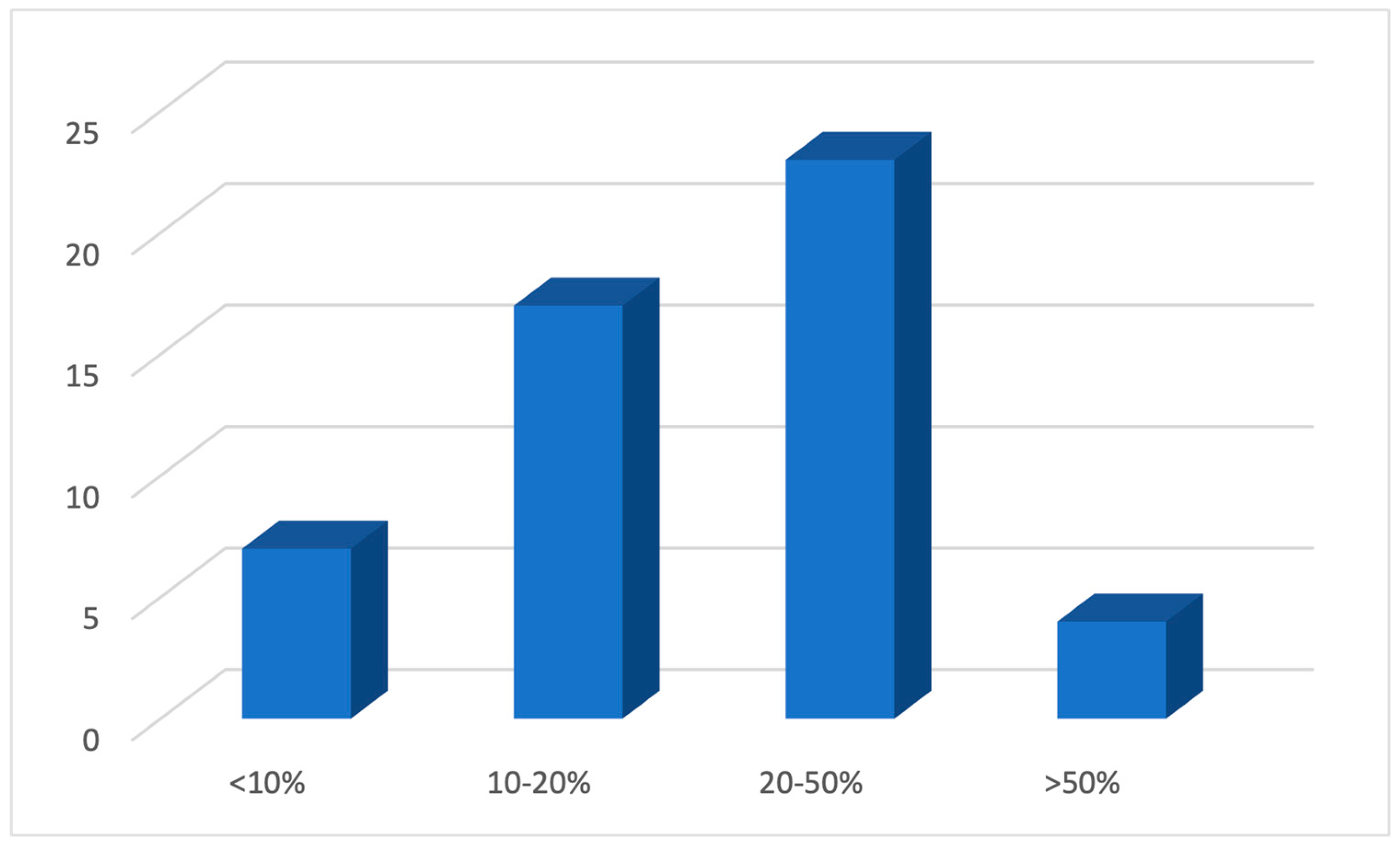
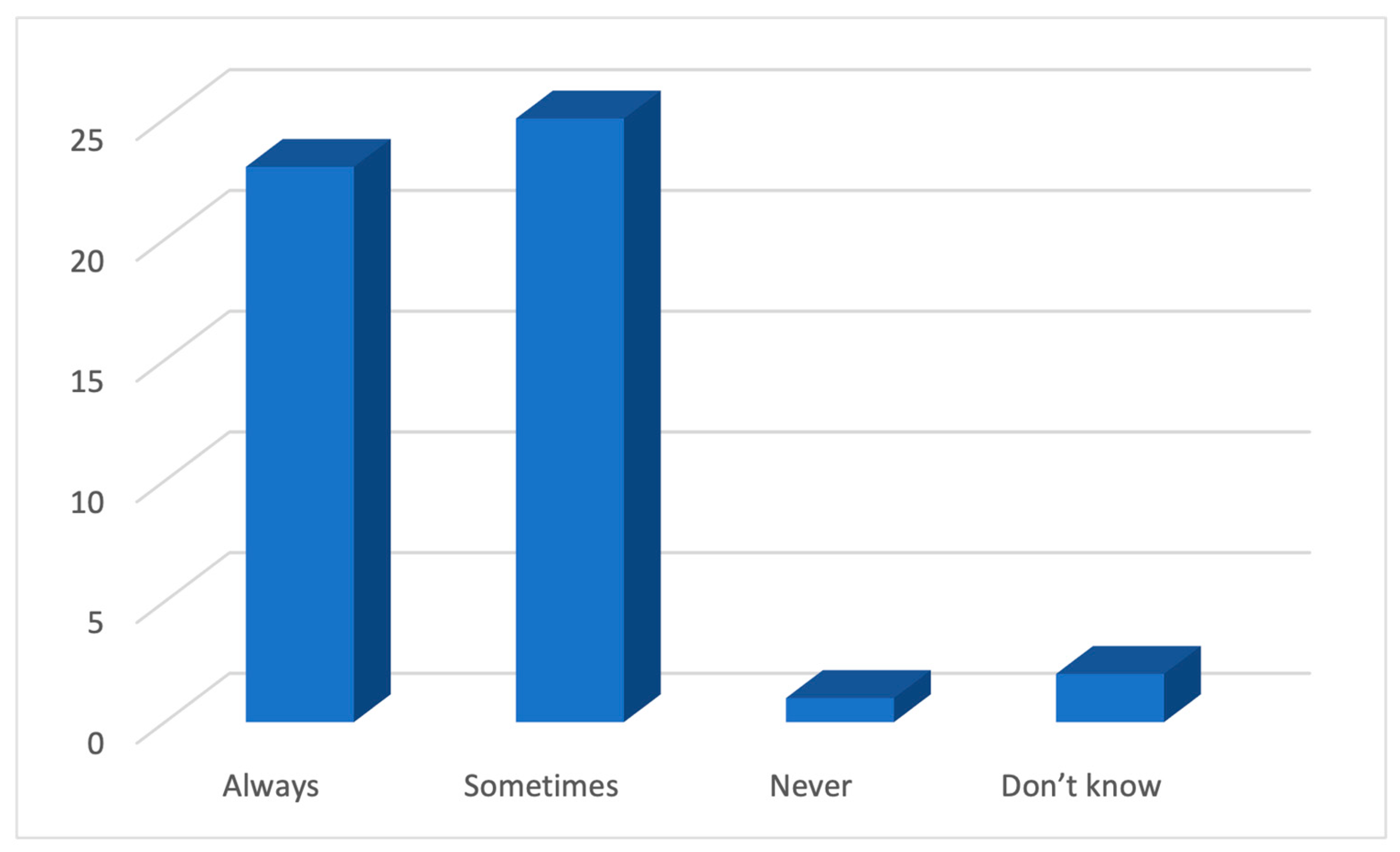
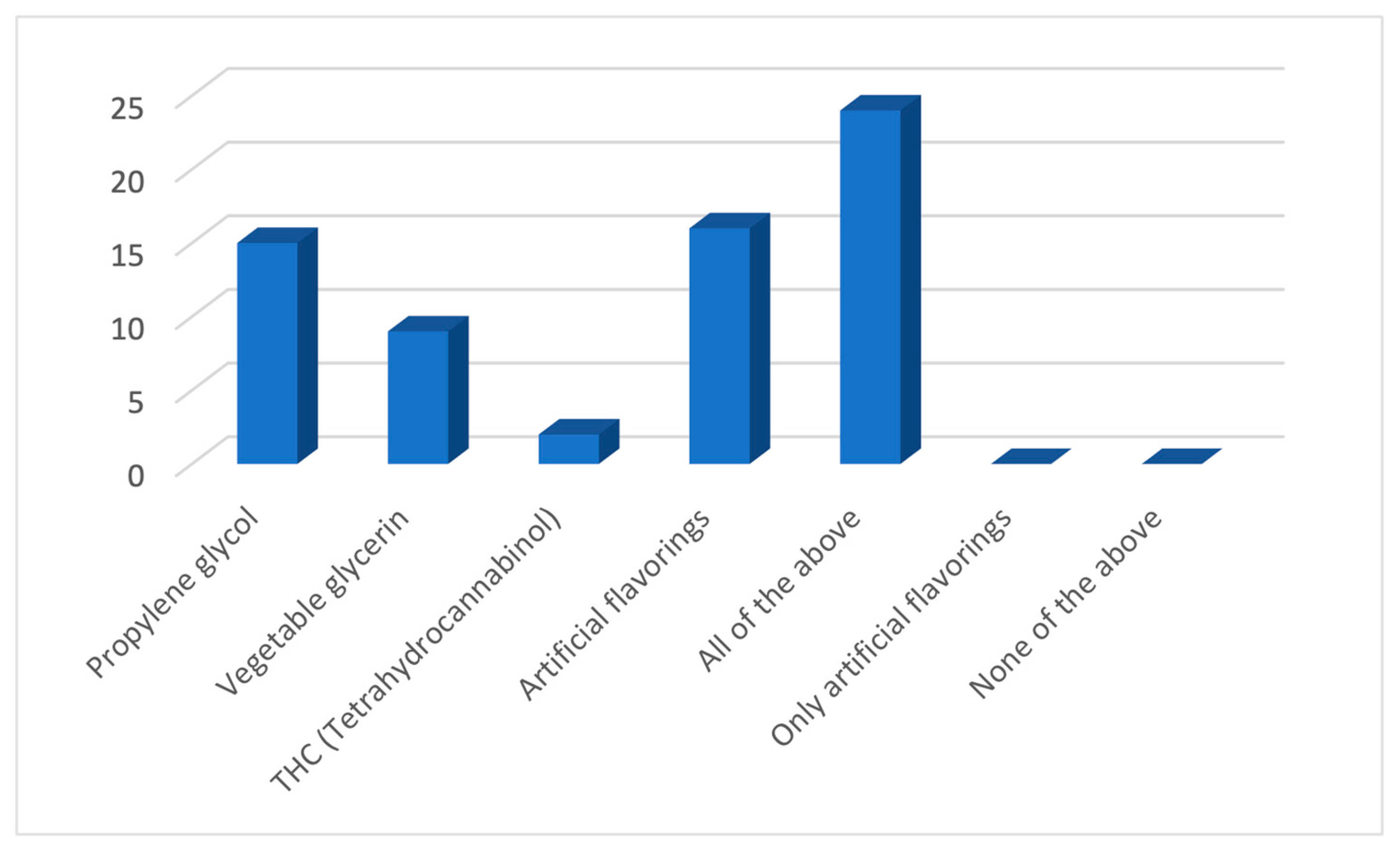
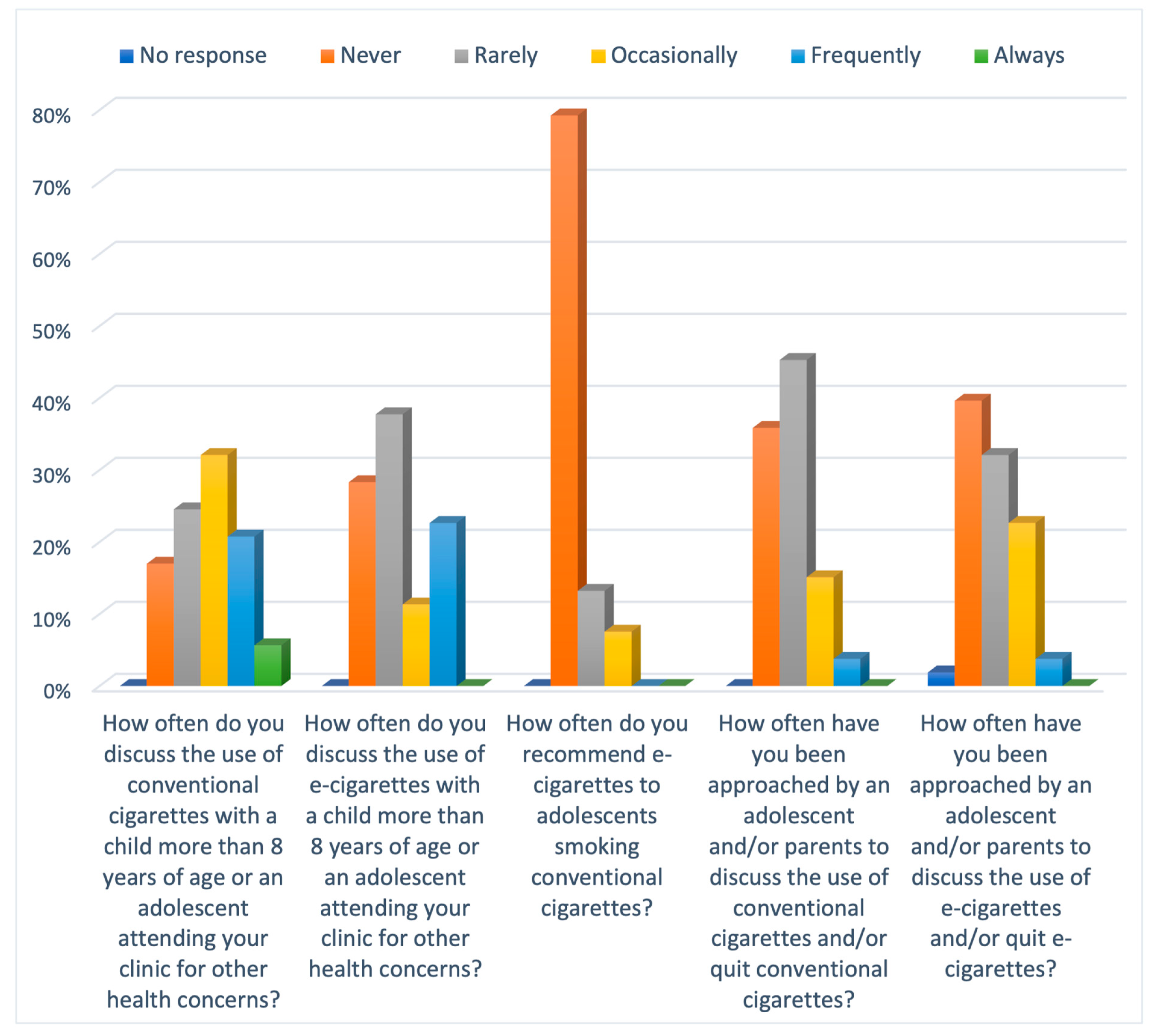

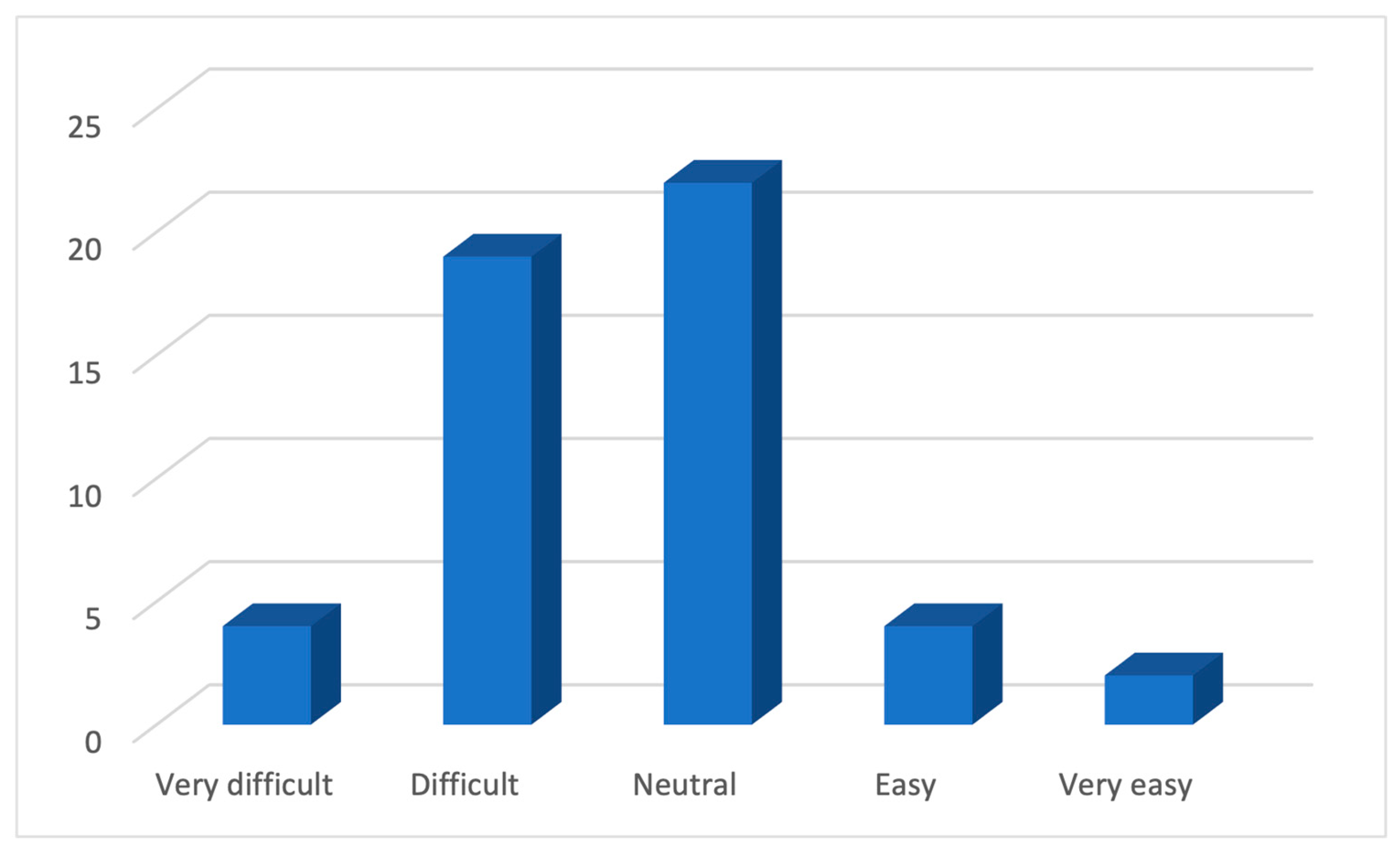
| Characteristics of Participating GP | Number (n) | Percentage (%) |
|---|---|---|
| Age | ||
| - <30-years-old | 4 | 7 |
| - 30–39-years-old | 5 | 9 |
| - 40–49-years-old | 16 | 30 |
| - 50–59-years-old | 12 | 23 |
| - >60-years-old | 15 | 28 |
| - No response | 1 | 2 |
| Gender | ||
| - Male | 24 | 45 |
| - Female | 29 | 55 |
| Years of professional practice: | ||
| - <2 years | 3 | 6 |
| - 2–5 years | 8 | 15 |
| - 5–10 years | 3 | 6 |
| - 10–20 years | 10 | 19 |
| - >20 years | 29 | 55 |
| Estimated number of children and adolescents between 8 and 18 years of age reviewed per week: | ||
| - <20 | 33 | 62 |
| - 20–50 | 19 | 36 |
| - 50–100 | 1 | 2 |
| - >100 | 0 | 0 |
| Country of primary qualification: | ||
| - Australia | 26 | 49 |
| - Others | 26 | 49 |
| - No answer | 1 | 2 |
| Socio-Economic Indexes for Areas (SEIFA) | ||
| - <50 percentile within Australia | 11 | 21 |
| - 50–75 percentile within Australia | 19 | 36 |
| - >75 percentile within Australia | 21 | 40 |
| No response | 2 | 3 |
| Statement | Strongly Disagree n (%) | Disagree n (%) | Neither Agree nor Disagree n (%) | Agree n (%) | Strongly Agree n (%) | Mean * |
|---|---|---|---|---|---|---|
| The use of e-cigarettes is harmful to the health of the user | 0 (0) | 0 (0) | 2 (4) | 17 (32) | 34 (64) | 4.6 |
| E-cigarettes are less harmful than conventional cigarettes | 6 (11) | 15 (28) | 17 (32) | 14 (26) | 1 (2) | 2.8 |
| The use of e-cigarettes can cause respiratory distress | 0 (0) | 0 (0) | 1 (2) | 24 (45) | 28 (53) | 4.5 |
| The use of e-cigarettes can cause cardiac disease | 0 (0) | 2 (4) | 5 (9) | 27 (51) | 19 (36) | 4.2 |
| The use of e-cigarettes can potentially cause burns and injuries | 0 (0) | 1 (2) | 7 (13) | 29 (55) | 16 (30) | 4.1 |
| Non-smokers who use e-cigarettes are more likely to initiate cigarette smoking | 0 (0) | 2 (4) | 9 (17) | 24 (45) | 18 (34) | 4.1 |
| Among non-smokers, e-cigarette use results in dependence on e-cigarettes | 0 (0) | 1 (2) | 5 (9) | 30 (57) | 17 (32) | 4.2 |
| E-cigarettes can be addictive | 0 (0) | 0 (0) | 2 (4) | 23 (43) | 28 (53) | 4.5 |
| E-cigarettes are less addictive than conventional cigarettes | 9 (17) | 24 (45) | 13 (26) | 6 (11) | 1 (2) | 2.4 |
| E-cigarettes should be recommended as a smoking cessation tool | 10 (19) | 21 (40) | 16 (30) | 3 (6) | 3 (6) | 2.4 |
| Smokers who do not want to quit smoking should be offered and encouraged to use e-cigarettes | 9 (17) | 15 (28) | 19 (36) | 9 (17) | 1 (2) | 2.6 |
| Statement | Very Confident n (%) | Moderately Confident n (%) | Somewhat Confident n (%) | Not Confident at All n (%) |
|---|---|---|---|---|
| How confident do you feel advising a child or an adolescent about the use of conventional cigarettes? | 19 (36) | 11 (21) | 19 (36) | 4 (8) |
| How confident do you feel advising a child or an adolescent about the use of e-cigarettes? | 5 (9) | 12 (23) | 19 (36) | 17 (32) |
Disclaimer/Publisher’s Note: The statements, opinions and data contained in all publications are solely those of the individual author(s) and contributor(s) and not of MDPI and/or the editor(s). MDPI and/or the editor(s) disclaim responsibility for any injury to people or property resulting from any ideas, methods, instructions or products referred to in the content. |
© 2024 by the authors. Licensee MDPI, Basel, Switzerland. This article is an open access article distributed under the terms and conditions of the Creative Commons Attribution (CC BY) license (https://creativecommons.org/licenses/by/4.0/).
Share and Cite
Singh, R.; Burke, M.; Towns, S.; Rahman, M.A.; Bittoun, R.; Shah, S.; Liu, A.; Bhurawala, H. Exploring General Practitioners’ Knowledge, Attitudes, and Practices towards E-Cigarette Use/Vaping in Children and Adolescents: A Pilot Cross-Sectional Study in Sydney. Int. J. Environ. Res. Public Health 2024, 21, 1215. https://doi.org/10.3390/ijerph21091215
Singh R, Burke M, Towns S, Rahman MA, Bittoun R, Shah S, Liu A, Bhurawala H. Exploring General Practitioners’ Knowledge, Attitudes, and Practices towards E-Cigarette Use/Vaping in Children and Adolescents: A Pilot Cross-Sectional Study in Sydney. International Journal of Environmental Research and Public Health. 2024; 21(9):1215. https://doi.org/10.3390/ijerph21091215
Chicago/Turabian StyleSingh, Rajiv, Michael Burke, Susan Towns, Muhammad Aziz Rahman, Renee Bittoun, Smita Shah, Anthony Liu, and Habib Bhurawala. 2024. "Exploring General Practitioners’ Knowledge, Attitudes, and Practices towards E-Cigarette Use/Vaping in Children and Adolescents: A Pilot Cross-Sectional Study in Sydney" International Journal of Environmental Research and Public Health 21, no. 9: 1215. https://doi.org/10.3390/ijerph21091215
APA StyleSingh, R., Burke, M., Towns, S., Rahman, M. A., Bittoun, R., Shah, S., Liu, A., & Bhurawala, H. (2024). Exploring General Practitioners’ Knowledge, Attitudes, and Practices towards E-Cigarette Use/Vaping in Children and Adolescents: A Pilot Cross-Sectional Study in Sydney. International Journal of Environmental Research and Public Health, 21(9), 1215. https://doi.org/10.3390/ijerph21091215








